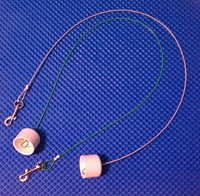TETHERS – Part 2 THE TRAINING TECHNIQUES (a blast from the past – 2011)
In the last blog, I highlighted the mechanics of the tether and indicated there were three specific training techniques that the tether was outstanding to be used for. So let’s get to it!
The first technique I want to cover is how to greet people at the door without barking, jumping and or freaking out when new people enter the front door. I really wish more people understood that dogs can learn as much if they are never presented the opportunity to make mistakes than waiting for bad behaviors to be learned and then fixed.
When I have a client call me and talk about a dog that rushes the door, jumps on people or is just plain snarky at the door when people are trying to enter the house, I will recommend using a tether to eliminate the chance for making a mistake and to teach the Park It command. I encourage the client to make sure they are also using the 15 minute ignore as part of this training to change the behavior. Park It and 15 minute ignore are already articles on my blog, but suffice it to say, Park It is a command like go to bed or kennel up, but only in a different location such as the their tether spot. The 15 minute ignore is simply a technique where by giving no attention to bad behavior as well as time to calm down, most dogs will choose the behavior we want.
The scenario goes something like this…the doorbell sounds and guess what…so does Fido. Next we use the Park It command to get Fido to go to his place; a nice comfy bed by the tether point. Once the dog is on the bed you connect the tether. Then you answer the door. Fido can still bark, but can no longer make the mistake of rushing or jumping up on your house guest. Then you incorporate the 15 minute ignore by having the house guest grab a seat and ignore the dog. Obviously, you need to pick a tether spot where the dog can see the door but can still give your guest a dog free route to a chair or couch. You then explain to your guest that you are working on training Fido to greet people in an appropriate manner, and they can help you by simply not looking at, talking to or, for goodness sake, touching Fido for roughly 15 minutes. Whether you know it or not, most dogs have an attention span somewhere between a rock and a gnat, and if ignored they quickly realize the behavior is not getting them what they want (attention) and they give up on the behavior. This gives us the opportunity to have our guest ask Fido for a sit and give him a treat, all while Fido is tethered so he still cannot make the mistake of jumping up. Once Fido is calm with this step, then and only then do we disconnect the tether.
Another positive outcome of this technique is the fact that once Fido sees you interacting with the guest and being totally okay with the situation, Fido starts to think “well if Mom is okay with this person, I guess I am too.” You have now eliminated the mistake of rushing and jumping on guests, reinforced the command of “Park It” and begun the process of positively associating new house guests with presents (rewards/treats.)
In the end, you and your guests end up with what you both want; a calm dog that knows how to say hello the right way. The tether is actually only needed early on to reinforce “Park It” and help eliminate the dog from making mistakes. You can even begin using the “Park It” command at dinner, to eliminate the begging dog scenario during meal times. But remember to give your pooch a reward for being on their place during dinner. After all, they should be rewarded for this type of behavior. I use stuffed Kong’s and stuffed femur bones as a way to reward such polite behavior!
The other main way I use a tether is to take commands like sit, down and stay to the “graduate” level of learning or being able to get these commands to work from a distance. In essence, if my dog is 15 feet from me and I say sit, I want the dog to sit where they are, not come all the way to me and then sit. Another quick tip on dogs is that they are unable to generalize or transfer a skill from one situation or location to another different one. That being said, a dog that you can ask to sit and stay, while you walk 15 feet away, and still reliably hold the stay will not be able to relate to a command given at a distance until they are re-taught the commands from a distance. This is where the tether comes in. Once again, we only use the tether to introduce the new idea and to eliminate the chance of making a mistake.
Remember that your training sessions should be short and sweet, about 15 minute each, a couple of times a day. We don’t want Fido to lose interest. So, how do you do it? The first step is to ask the dog to Park It or go to their place and attach the tether. Now put 4 to 5 feet of distance between you and the dog and begin the training process of asking for different behaviors such as sit, down, watch me or even stand. After several days or maybe a week, the dog should be comfortable with their newly learned skills, and the tether should be removed. Again, the goal is to help the dog jump start their learning and to eliminate mistakes. The tether is, in many ways, much like the clicker, something to help facilitate training, not something that has to be used forever.
There are many instances where I see absolutely no place for using a tether in dog training, but the training techniques mentioned above are very useful and still positive in nature. As I have said before, no tool is positive or negative; it is how people use them that should be judged as right or wrong!
A final thought many folk will choose to use the ideas above and simply use a crate vs the tether and that is fine… Again it is simply the idea of using a different management device for the same purpose. Also these ideas are not for use with aggressive, fearful or anxious dogs… they might still be an option but need the experienced eye of of a professional trainer to help with the process
Related Posts
Search Blogs
Most Popular Posts
K.I.S.S. Dog Training proudly serves the Kansas City Metro, Overland Park and Surrounding Areas. 40 miles, 20 miles each way from Shawnee, KS is included for In-Home Sessions... Over that mileage is an additional charge of $1.00 per mile... Call with Questions
Contact Us Today!
K.I.S.S. Dog Training
Shawnee, Kansas
(913) 269-7595








